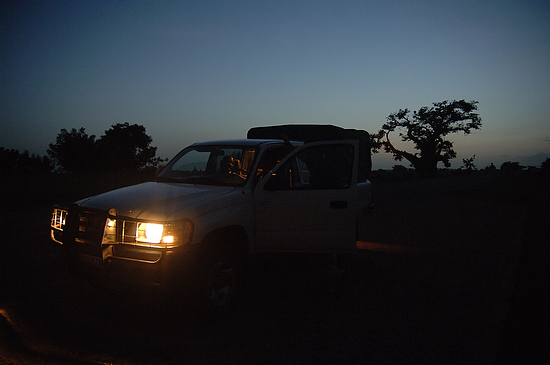 |
| [Nikon D2X, 24mm ƒ/2.8, 1/4, ISO 800] Ismael Tarnagda and Jay Shafto wind up a long day in Sabtenga, Burkina Faso. |
1. You need a faster lens to capture a sceneIf you are still shooting film and don’t have a digital camera shooting fast glass is a necessity in low light. Kodachrome only went to ISO 200 and sure you could push the ISO and pay extra to process, but the quality just falls a part.
2. You need a faster lens to increase the shutter-speed
3. Bokeh: You want a silky smooth out of focus background and/or foreground
3.5. Status symbol
If you shoot color negative film you can find ISO 1600, but again there is a lot of grain to contend with in your photos.
 |
| [Nikon D2X, 28mm ƒ/2.8, 1/10, ISO 800] Ismael Tarnagda and Jay Shafto wind up a long day in Sabtenga, Burkina Faso. |
On my Nikon D4 the ISO is expanded to 204,800. This looks better than my film did at ISO 1600.
This is all to say that if you cannot increase your ISO for any reason you need a faster lens to capture a photo. One of the first lenses many photographers first buy to get the faster glass is the 50mm ƒ/1.4. This lens is affordable as compared to almost every other ƒ/1.4 lens. The Nikon 50mm ƒ/1.4 sells for about $289 on the street.
Many of Nikon’s cameras come in a kit with the 18-105mm f/3.5-5.6G ED AF-S DX (VR) Lens. By adding the 50mm ƒ/1.4 the photographer gains 2 ƒ-stops.
If you are shooting architecture getting faster glass isn’t that important for the most part. Most of these photographers are stopping down the glass to get everything in focus. Also, they can put the camera on a tripod and since their subject doesn’t move they can shoot a long exposure time.
If you shoot people, then shooting much slower than 1/30 shutter speed will capture motion blur due to the subject moving.
Stanley’s Shutter Speed Guidelines
- 1/30 for people when they are stationary. You could do family portraits with your camera on a tripod (to avoid photographer movement) to get good results.
- 1/500 for sports. This is for most sports you can get sharp photos of the athletes. Things like football, basketball, and baseball will fall into these sports that will work at 1/500.
- 1/2000 for high-speed sports. If you want to freeze the hockey puck or the motorcyclist in a race you need to crank up that shutter speed even more.
These are just ways to evaluate your need for faster glass in a situation.
With today’s zoom lenses being incredibly sharp as compared to earlier models they rival the sharpness of some of their prime lenses counterparts. Due to this increased quality I recommend finding a zoom that fits your style of shooting.
 |
| [Nikon D3, 16mm ƒ/2.8, ISO 6400, 1/50] Sunrise in North Georgia for a balloon ride over Lake Lanier. |
Here are some of my recommendations from Nikon’s lens lineup.
Zooms
Photojournalism/Documentary/Street Shooters
- Wide Angle Zoom (one of these)
- AF-S NIKKOR 14-24mm f/2.8G ED
- AF-S NIKKOR 16-35mm f/4G ED VR
- AF-S Zoom-Nikkor 17-35mm f/2.8D IF-ED
- General Zoom (one of these)
- AF-S NIKKOR 24-120mm f/4G ED VR
- AF-S NIKKOR 28-300mm f/3.5-5.6G ED VR
 |
| [Nikon D4, 105mm of 70-200mm ƒ/2.8 1/640 ISO 12,800] |
- AF-S NIKKOR 200-400mm f/4G ED VR II
 |
| [Nikon D4, 85mm ƒ/1.4, 1/100, ISO 800] |
Photojournalism/Documentary/Street Shooters
- AF-S NIKKOR 24mm f/1.4G ED
- AF-S NIKKOR 28mm f/1.8G
- AF-S NIKKOR 35mm f/1.4G
- AF-S NIKKOR 50mm f/1.4G
- 85mm (either one)
- AF-S NIKKOR 85mm f/1.4G
- AF-S NIKKOR 85mm f/1.8G
- AF-S NIKKOR 400mm f/2.8G ED VR
- AF-S NIKKOR 600mm f/4G ED VR
 |
| [Nikon D4, 85mm ƒ/1.4, 1/250, ISO 100] |
If you desire the silky smooth Bokeh there is another thing that affects the background—sensor size. This is especially true when you go to the smaller chips. The lens gets closer to the sensor and when this happens the depth-of-field increases. This is why your smartphone photos look in focus with a ƒ/2 lens. It is like shooting at ƒ/8 or ƒ/16 with a full-framed DSLR.
Buy a full-framed sensor camera to get the silkiest of all backgrounds.








































